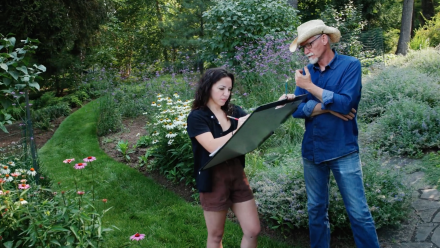Facts
Location
United Kingdom
Nemetschek Group Brands
Vectorworks
Technology used
Vectorworks Landmark
The Royal Horticultural Society's roots place it as a pioneer of horticultural research, although for many it is known for its extravagant flower shows that draw thousands from around the globe. In the UK, their gardens and laboratories serve as foundations for pointed inquiry about the ways plants contribute to mental and societal well-being.
Their flagship garden, RHS Garden Wisley, opened their newest exhibit at the RHS Hilltop and the Home of Gardening Science on June 24, 2021. It’s the UK’s first dedicated horticultural science center and aims to advance the horticulture industry through education. The new gardens and gardening science center invite visitors to spectate research in the laboratories and three gardens, two of which were designed over the course of five years by Ann-Marie Powell Gardens Ltd.
Ann-Marie Powell, Master Designer and TV Personality
Perhaps known for her appearances on UK shows Garden Doctors, Garden SOS, The Great Garden Challenge, and Real Gardens, Ann-Marie Powell is certain of one thing above all else — that gardening and horticulture are her life’s passions.
She decided to study horticulture after travelling the world in her early 20s. She remains inspired by the landscapes of India, Singapore, South America, and Thailand, and she says that her travels inspired her to devote the rest of her life to horticulture.
Following her studies, she began taking on private design projects for almost any client she could find. “At this point, I was still trying to figure out how to do it all. I remember pouring over countless books — we didn’t have internet yet — and example projects to do the best I could.”
Powell slowed on TV appearances in 1998 to start her own practice, Ann-Marie Powell Gardens Ltd., which is now the recipient of dozens of awards from the Royal Horticultural Society and elsewhere, including a gold medal for the MacMillan Garden at RHS Hampton Court, a Gold Medal for the Green and Blacks garden at RHS Chelsea Flower Show, and the American Horticultural Society’s Environmental Award for her Nature Amplified garden at the Philadelphia Flower Show.
Designing the New Gardens at Wisley Hilltop
Over five years prior to the opening of the new Wisley Home of Gardening Sciences, RHS announced a competition to design three new landscaped gardens to surround the sciences building. Powell saw the announcement on Twitter and was thrilled at the opportunity.
The competition’s 40-page brief indicated that this was no minor job. After all, the winner would get to design what would become known as one of the most beautiful and scientifically advanced gardens in the world.
The brief called for a World Food Garden, a Wildlife Garden, and a Well-being Garden. The Hilltop’s position with 360-degree access to sunshine made the project a horticulturist’s dream.
The RHS Wisley World Food Garden
As visitors approach the World Food Garden, they’re greeted by sizable steel arches covered in greenery and edibles like squash and passion fruit. The arches serve as an invitation, their spectacle urging visitors into the lush greenery.
“My first thoughts when putting together concepts for the World Food Garden were that it should be diverse and promote horticulture in all forms; it should be accessible to you, no matter your age group, your income bracket, and your ethnic background,” Powell said. “There should be something for everyone to enjoy in the garden, be you a keen gardener, be you dragged along by your keen gardening partner or parents. It should be fun and interactive and really engage the individual.”
Powell received the site’s master plan and was surprised to see oval shapes. “Traditionally speaking, a walled garden or a traditional English breakfast garden is rectangular or square and it’s an enclosed, walled space, whereas the shape we inherited from the master landscape plan was an oval,” she said. “That immediately set the cat among the pigeons on the World Food Garden, but it actually encouraged me to be more experimental with the actual layout of the space itself.”
The resulting layout is inspired by plant cells; irregular rounded shapes make up various planting “pods” through the World Food Garden. “You can look at just one cell and think, ‘Oh, O.K., I can do that at home!’ Powell said, explaining how the thought behind these planting beds was to inspire visitors to experiment with growing vegetables and herbs in their own gardens.
The RHS intentionally chooses vegetables that aren’t complicated to grow at home — traditional vegetables like broccoli, potatoes, lettuce, cabbage, and cauliflower, for example. “They’re simple vegetables but they’re the best varieties around,” Powell said, “showing that the RHS wants you to be successful at home.”
Powell describes the space as beautiful and full of scent. It’s set up like a maze — though not one where visitors are likely to get lost — for visitors to traverse and witness the cultivation of local and exotic foods.
Pollinating insects help with the production of vegetables, as do pollinating plants. Powell said these two inclusions demonstrate the importance of plant diversity in a garden design.
“The gardens around the space don’t just have to be beautiful,” Powell said. “They must be useful as well. People must be able to interpret the design very quickly and very easily and be inspired to actually do similar forms of gardening when they’re back home.”
Each of these design elements contribute to the marvel that is the Wisley World Food Garden, which is also used for a spectacular plot-to-plate experience. Visitors can peruse the garden then stop for a meal at the Wisley Café and eat the very food they just saw growing outside.
Ann-Marie Powell
We couldn’t have done the project without Vectorworks. There’s absolutely no doubt about that.
The RHS Wisley Wildlife Garden
Positioned adjacent to the World Food Garden, the Wildlife Garden centers on the idea that water is essential to all life. The layout includes large ponds that contrast with hardscapes and planting beds. Paths are scattered and winding, symbolizing humanity’s imperfect relationship with nature.
“For a while, I really did struggle coming up with a concept for the Wildlife Garden,” Powell said, “but then I thought, ‘well, if we’re doing a wildlife garden, let’s start with wildlife.’”
She stumbled upon the anatomy of a bee’s wing and found her inspiration.
“When you look at a bee’s wing closely, it’s really quite awkward in its layout and segmentation,” she said. “It really made me feel that nature is fragile and we’re not perfect. We’re part of the biodiversity of the world and we’re part of the ecosystem and we deal with nature in a very imperfect way.”
Plants are extraordinarily tall in the wildlife garden, standing eye-level and inviting visitors to get up close and personal, Powell said. “The eye is constantly taken up to the sky, so you feel like you’re a part of the much bigger picture.”
The Wildlife Garden spans roughly an acre, a massive scheme. “This can be overwhelming for some,” Powell said, “so we’ve created a smaller human-scale garden in this area that’s popping with color.” She said the purpose of this space is for visitors to be able to take what they learn about biodiversity and apply it on a much smaller scale at home.
Local wildlife populates the gardens. Powell shared that dragonflies are buzzing about, and that a family of ducks moved into one of the ponds as soon as it was created.
The Design Language of Vectorworks
Powell, as with many others, learned her trade by drafting with pencil and paper. This was how she delivered projects for decades, until a turning point; as she took on more and more work, she wanted to be able to communicate effectively and make changes quickly. It appeared shifting from hand drawings to digital design was the way to go. It just took too much time to make client revisions with hand sketches, she said.
With Vectorworks Landmark, Powell and team can speak a common language — the language of design.
“That’s the thing with the Wisley project,” Powell said. “We’ve literally produced hundreds of drawings. If you were going to hand draw all of those . . . you just couldn’t.”
She praises Vectorworks as a “multifunctional language tool” for its ability to enable quick communication about a design in an effective and reliable way. She also appreciates the ability to visualize spatial relationships in 3D, something she wouldn’t have thought were possible when designing private gardens two decades ago.
“We couldn’t have done the project without Vectorworks,” Powell said. “There’s absolutely no doubt about that.”





